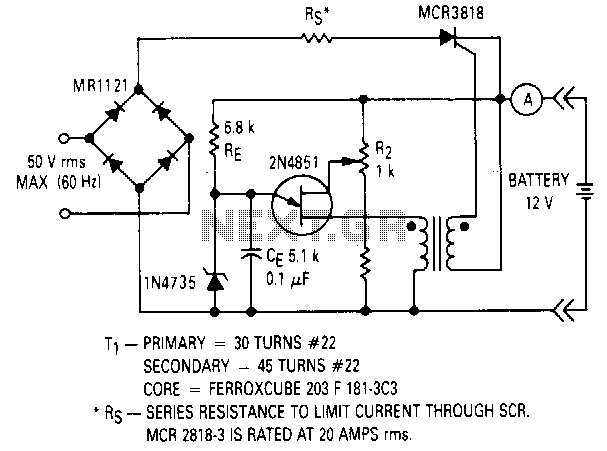
Ujt-battery-charger

This circuit will not function unless the battery to be charged is connected with the correct polarity. The voltage of the battery regulates the charger, and when the battery is fully charged, the charger will stop supplying current to it. The charging current for the battery is provided through the SCR, which is triggered into the conducting state by the UJT relaxation oscillator. The oscillator activates only when the battery voltage is low. V8281 of the UJT is derived from the voltage of the battery being charged, and since Vp equals Vn equals V8281, a higher V8281 results in a higher Vp. When Vp exceeds the breakdown voltage of the zener diode Z1, the UJT will stop firing, and the SCR will cease conduction. This indicates that the battery has reached its desired charge level as determined by R2.
The described circuit functions as a battery charger utilizing a Unijunction Transistor (UJT) oscillator and a Silicon Controlled Rectifier (SCR) for controlling the charging process. The circuit is designed to ensure that the battery is charged correctly and safely, with built-in safeguards against overcharging.
At the heart of the circuit is the UJT relaxation oscillator, which generates a pulse signal that triggers the SCR. The oscillator is designed to activate only when the battery voltage drops below a certain threshold, ensuring that charging occurs only when necessary. The voltage across the battery (denoted as V8281) directly influences the operation of the UJT. As the battery voltage rises, Vp (the peak voltage of the UJT) also increases, leading to a situation where Vp can reach a critical level.
When Vp surpasses the breakdown voltage of the zener diode Z1, this condition effectively disables the UJT from firing. As a result, the SCR is no longer triggered, halting the current flow to the battery. This mechanism provides a reliable method for preventing overcharging, as the battery will only receive current until it reaches the charge level set by the resistor R2, which is part of the circuit's feedback loop.
In summary, the circuit employs a combination of a UJT oscillator and an SCR to manage the battery charging process, ensuring that the battery is charged efficiently and safely while preventing overcharging through voltage regulation and feedback mechanisms.This circuit will not work unless the battery to be charged is connected with proper polarity. The battery voltage controls the charger and when the battery is fully charged, the charger will not supply current to the battery. The battery charging the current is obtained through the SCR when it is triggered into the conducting state by the UJT relaxation oscillator.
The oscillator is only activated when the battery voltage is low. V8281 of the UJT is derived from the voltage of the battery to be charged, and since Vp= Vn= V8281 ; the higher V828" the higher Vp. When Vp exceeds the breakdown voltage of the zener diode Zl, the UJT will cease to fire and the SCR will not conduct.
This indicates that the battery has attained its desired charge as set by R2. 🔗 External reference
The described circuit functions as a battery charger utilizing a Unijunction Transistor (UJT) oscillator and a Silicon Controlled Rectifier (SCR) for controlling the charging process. The circuit is designed to ensure that the battery is charged correctly and safely, with built-in safeguards against overcharging.
At the heart of the circuit is the UJT relaxation oscillator, which generates a pulse signal that triggers the SCR. The oscillator is designed to activate only when the battery voltage drops below a certain threshold, ensuring that charging occurs only when necessary. The voltage across the battery (denoted as V8281) directly influences the operation of the UJT. As the battery voltage rises, Vp (the peak voltage of the UJT) also increases, leading to a situation where Vp can reach a critical level.
When Vp surpasses the breakdown voltage of the zener diode Z1, this condition effectively disables the UJT from firing. As a result, the SCR is no longer triggered, halting the current flow to the battery. This mechanism provides a reliable method for preventing overcharging, as the battery will only receive current until it reaches the charge level set by the resistor R2, which is part of the circuit's feedback loop.
In summary, the circuit employs a combination of a UJT oscillator and an SCR to manage the battery charging process, ensuring that the battery is charged efficiently and safely while preventing overcharging through voltage regulation and feedback mechanisms.This circuit will not work unless the battery to be charged is connected with proper polarity. The battery voltage controls the charger and when the battery is fully charged, the charger will not supply current to the battery. The battery charging the current is obtained through the SCR when it is triggered into the conducting state by the UJT relaxation oscillator.
The oscillator is only activated when the battery voltage is low. V8281 of the UJT is derived from the voltage of the battery to be charged, and since Vp= Vn= V8281 ; the higher V828" the higher Vp. When Vp exceeds the breakdown voltage of the zener diode Zl, the UJT will cease to fire and the SCR will not conduct.
This indicates that the battery has attained its desired charge as set by R2. 🔗 External reference